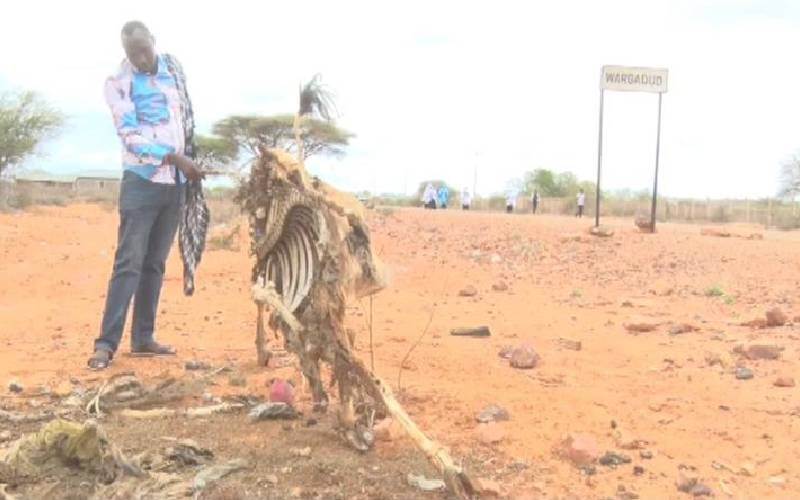
As the worst drought in four decades continues to wreak havoc across the Horn of Africa, several governments including Kenya, Somalia and Ethiopia, are struggling to respond to the crisis amidst dwindling resources.
The drought has resulted in catastrophic levels of humanitarian need and environmentalists and stakeholders are hopeful that COP27, which Egypt will host, will address the crisis.
Currently, more than 20 million people are on the brink of starvation, 10 million of them children.
Rania Dagash, Unicef deputy regional director for Eastern and Southern Africa, painted a grim picture of the effects of drought on children.
In Hunger Crisis: Responding to Drought in the Horn of Africa, she shared the upsurge in child deaths and feared more will be recorded based on the recent weather prediction by the World Metrological Organisation (WMO), which last week predicted persistence of drought, with October-December forecasts showing a high chance of drier-than-average conditions.
"I met a mother in Dolo on the border of Somalia and Ethiopia on the Somali side and she was pregnant, had two children, one-year-old twins," Dagash recalled. "She had walked for 160 kilometres to make it to the camp where we have been at the forefront in this response."
According to Dagash, many more are left behind and "I cannot get out of my head, the tiny mounds of earth that mark children's graves when you enter a camp that has just been set up. Other mothers buried children along the way to the camp".
Dagash challenged world leaders attending COP27 to rethink the funding for malnutrition and drought as "we need longer-term predictable funding to stop needless deaths".
She said that the drought response was flagged early but the response was very slow. She said support from USAID helped avert a massive explosion of child deaths.
"At the sharp end of this drought is a climate and a human-made crisis that children did not create yet they are highly affected simply because the world did not act in time," she said.
Lauren Landis, World Food Programme (WFP) country director for Kenya, said drought had not spared livestock either: "As you drive down country roads, you see carcasses on both sides of the road and about 4.5 million livestock have died since the onset of the drought."
And instead of distributing food, WFP opted to send Sh6,500 via mobile money transfers to support families every month. And from supporting four counties, the number has since increased to 15 counties.
Franz Celestin of the International Organisation for Migration (IOM) said the effects of increased drought-induced hunger on the general population was catastrophic.
Data from IOM shows that about one million people have been displaced, besides the 2.9 million who have been displaced by conflicts and other natural disasters over the years.
"Hunger has forced people to move and compete over resources, leading to communal violence and worsening displacement crisis," said Celestin, adding: "This is why I'm calling this drought a threat multiplier."
COP27, she said, should provide an integrated package solution that includes water hygiene, sanitation, shelter, nutrition, health and cash to displaced families.
Currently, about 450,000 people have been internally displaced in Somalia and IOM has provided about 400 million litres of water to those in need.
Samantha Power from the United States Agency for International Development (USAid) said she has seen "a degree of despair and deprivation that I have not seen in my two three-decade career travelling to places where heartbreaking things are happening," she said.
At the moment, nearly nine million livestock have already died in Ethiopia, Kenya and Somalia.
July recorded three million livestock deaths, the highest since the drought started.
"These are pastoralists; some used to possess more than 500 animals and suddenly they have four or zero with nothing to eat and no source of income," Samantha said, noting that for most "the option they have is to look for a humanitarian organisation for help".
She said this had led to a spike in suicide cases among pastoralists.
"There was a drought not nearly as severe as this one in the same region in 2017 with less severity in terms of numbers of people affected and the funding received was significantly higher," she said.
Compared to then, the funding is down by 66 per cent from what it was in response to the 2017 famine.
"We need other countries to step up in the ways that they have done in the past. We are hopeful that large powers like China will contribute at the scale," Samantha said.
 The Standard Group Plc is a multi-media organization with investments in media platforms spanning newspaper print
operations, television, radio broadcasting, digital and online services. The Standard Group is recognized as a
leading multi-media house in Kenya with a key influence in matters of national and international interest.
The Standard Group Plc is a multi-media organization with investments in media platforms spanning newspaper print
operations, television, radio broadcasting, digital and online services. The Standard Group is recognized as a
leading multi-media house in Kenya with a key influence in matters of national and international interest.

